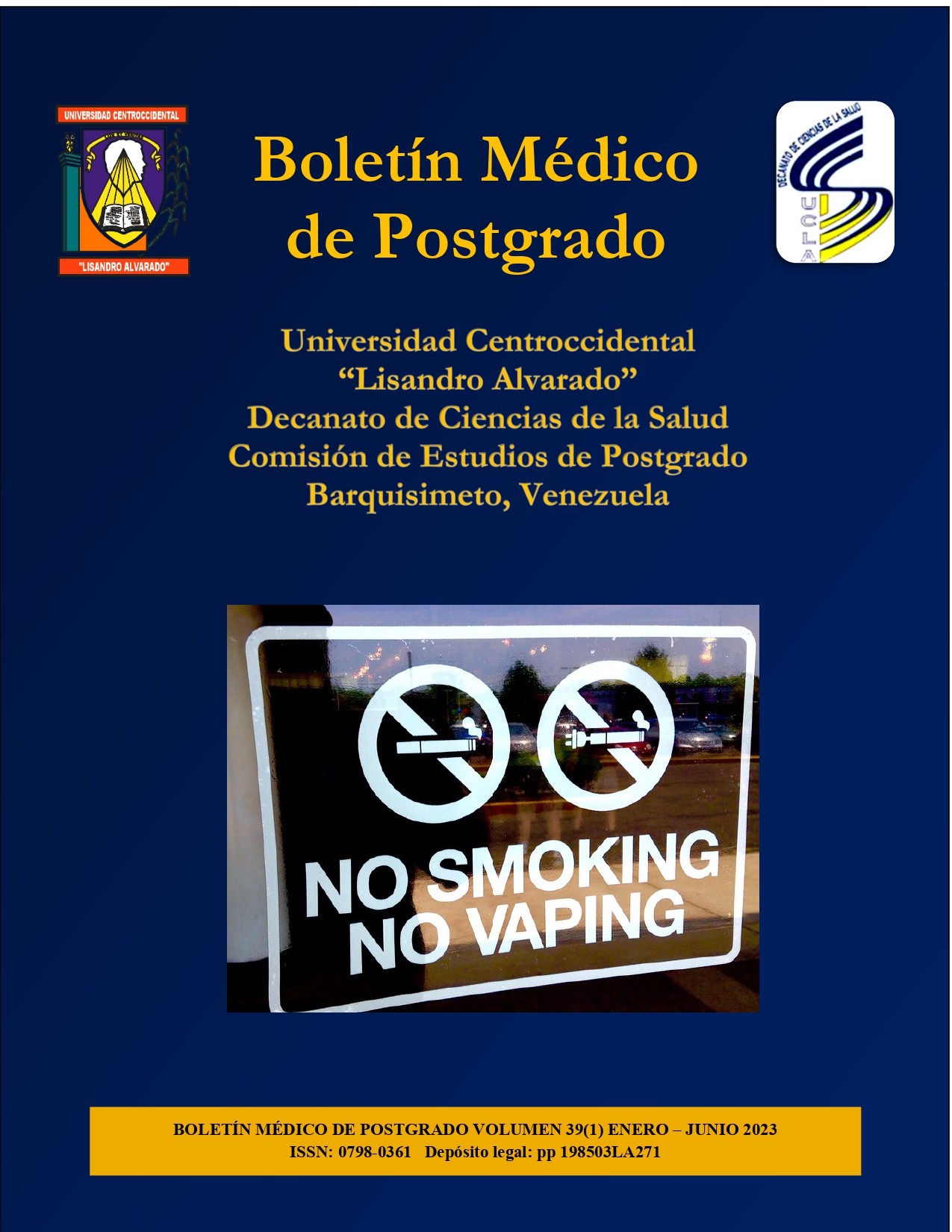Cardiovascular dysautonomia in post COVID-19 patients. IPSTAUCLA consult office, Barquisimeto, Lara state
Keywords:
coronavirus infections, cardiovascular diseases, autonomic nervous system diseases, standing position, carotid sinusAbstract
Following the COVID-19 pandemic, a new entity has emerged, the "post-COVID" syndrome, with multiple manifestations among which cardiovascular symptoms are mentioned. The aim of this study was to determine the frequency of cardiovascular dysautonomia in post-COVID-19 patients who attended the IPSTAUCLA clinic between July and December 2021. A cross-sectional descriptive study was conducted whose population consisted of 48 post-COVID-19 patients; those with a history of dysautonomia or current use of vasodilator drugs, β-blockers, nonpyrimidine calcium channel blockers, and centrally acting sympatholytics were excluded. A structured questionnaire was administered that included questions on orthostatic intolerance and syncope (COMPASS survey), physical examination, and the modified RINES-VALCARDI and active standing tests. Cardiovascular dysautonomia was observed in 31% of post-COVID-19 patients according to the presence of alterations in at least one of the clinical diagnostic parameters; this was less frequent in those with more time elapsed since the active infection. Fifty-eight percent were female and 29% were between 50 and 59 years of age. Cardiovascular dysautonomia was present in 13% and 19% of patients with moderate and severe infection.
Downloads
References
Nishiga M, Wang D, Han Y, Lewis D, Wu J. COVID-19 and cardiovascular disease: from basic mechanisms to clinical perspectives. Nat Rev Cardiol 2020; 17(19): 543–558.
Organización Mundial de la Salud. Manejo Clínico de la COVID-19: Orientaciones evolutivas [serial online]. 25 de enero de 2021 [cited 2021 Jul 26]. Disponible en: https://apps.who.int/iris/bitstream/handle/10665/340629/WHO-2019-nCoV-clinical-2021.1-spa.pdf
Clemente-Herrera A, Sánchez-De la Torre EJ, Enríquez-Contreras JM. Manifestaciones cardiológicas en pacientes con COVID-19. Medicina Interna 2020; 36(3):357-364.
Huang C, Huang L, Wang Y, Li X, Ren L, Gu X, et al. 6-month consequences of COVID-19 in patients discharged from hospital: a cohort study. Lancet 2021; 397: 220–32.
Dixit N, Churchill A, Nsair A, Hsu J. Post-Acute COVID-19 syndrome and the cardiovascular system: what is known? AHJ Plus 2021; 100025.
Idiáquez J, Idiáquez J, Benarroch E, Evaluación clínica de las disautonomías. Rev Chil Neuro-psiquiatr 2020; 58(4): 324-336.
Arrais E, Mehta N, Távora-Mehta M, Ferreira C, Alves A, Neto J. Dysautonomia: A Forgotten Condition – Part I. Arq Bras Cardiol 2021; 116(4): 814-835.
Feigofsky S, Fedorowski A. Defining Cardiac Dysautonomia – Different types, overlap syndromes; Case-based presentations J Atr Fibrillation 2020; 13(1): 2403.
Alyesh D, Mathew J, Jordan R, Choe W, Sundaram S. COVID-19 Dysautonomia: An Important Component of “Long-Hauler Syndrome”. EP Lab Digest 2021; 21(4).
Treister R, O’Neil K, Downs H, Oaklander L. Validation of the Composite Autonomic Symptom Scale-31 (COMPASS-31) in patients with and without Small-fiber Polyneuropathy. Eur J Neurol 2015; 22(7): 1124-1130.
Chacín Alvarez L, Jatem E, Rojas C. Neuropatía autonómica cardiovascular diabética. Diabetes internacional. Volumen I. Nº1, 2009.
Rengel D, Chacín M, Ramírez K, Bermúdez-Pirela V. Prevalencia de Neuropatía Autonómica Cardiovascular por el método RINES VALCARDI modificado en individuos diabéticos de dos servicios de atención médica primaria de Puerto Ordaz, Edo. Bolívar, Venezuela. Revista Latinoamericana de Hipertensión 2019; 14(5).
Organización Panamericana de la Salud / Organización Mundial de la Salud. Actualización Epidemiológica Enfermedad por coronavirus (COVID-19) [serial online]. 2 de diciembre 2021 [cited 2 Dic 2021]. Washington, D.C: OPS/OMS; 2021. Disponible en: https://www.paho.org/es/file/101858/download?token=HEsHgjNk
Grubb B, Vesga B, Guzmán J, Silva F, Morillo C. Síndromes de disfunción autonómica asociados con intolerancia ortostática. Biomédica 2003; 23:103-14.
Bisaccia G, Ricci F, Recce V, Serio A, Iannetti G, Chahal AA, et al. Post-Acute Sequelae of COVID-19 and Cardiovascular Autonomic Dysfunction: What Do We Know? J Cardiovasc Dev Dis 2021; 8(11):156.
Dani M, Dirksen A, Taraborrelli P, Torocastro M, Panagopoulos D, Sutton R, et al. Autonomic Dysfunction in “long COVID”: Rationale, Physiology and Management Strategies. Clin Med (Lond) 2021; 21(1): e63-e67.
Blitzstein S, Whitelaw S. Postural Orthostatic tachycardia syndrome (POTS) and other autonomic disorders after COVID-19 infection: a case series of 20 patients. Springer – Immunologic Research [serial online] marzo 2021 [cited 2021 jul 26]. Disponible en: https://doi.org/10.1007/s12026-021-09185-5
Sociedad Española de Médicos Generales y de Familia (SEMG). Sociedad Española de Directivos de la Salud. Consenso para la atención integral al paciente post-COVID. Fundación AstraZeneca 2021; 4-7.
Shouman K, Vanichkachorn G, Cheshire W, Suarez M, Shelly S, Lamotte G, et al. Autonomic Dysfunction Following COVID-19 Infection: An Early Experience. Clin Auton Res 2021; 31(3): 385-394.
Published
How to Cite
Issue
Section

This work is licensed under a Creative Commons Attribution-NonCommercial-ShareAlike 4.0 International License.
Las opiniones expresadas por los autores no necesariamente reflejan la postura del editor de la publicación ni de la UCLA. Se autoriza la reproducción total o parcial de los textos aquí publicados, siempre y cuando se cite la fuente completa y la dirección electrónica de esta revista. Los autores(as) tienen el derecho de utilizar sus artículos para cualquier propósito siempre y cuando se realice sin fines de lucro. Los autores(as) pueden publicar en internet o cualquier otro medio la versión final aprobada de su trabajo, luego que esta ha sido publicada en esta revista.



